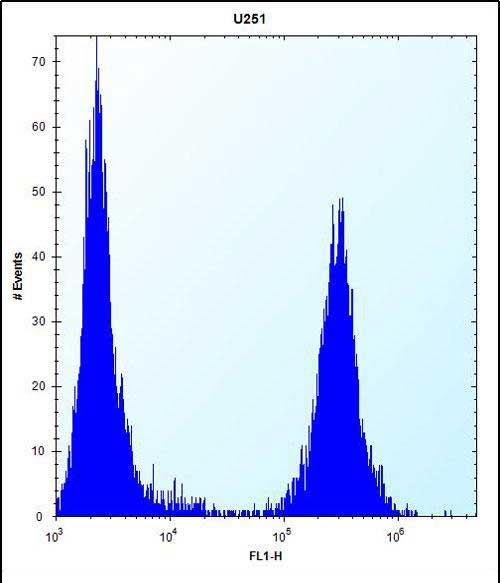TGFBI Antibody (N-term)
Affinity Purified Rabbit Polyclonal Antibody (Pab)
- 产品详情
- 实验流程
- 背景知识
Application
| WB, FC, E |
|---|---|
| Primary Accession | Q15582 |
| Other Accession | Q95215, O11780, P82198, NP_000349.1 |
| Reactivity | Human |
| Predicted | Mouse, Pig, Rabbit |
| Host | Rabbit |
| Clonality | Polyclonal |
| Isotype | Rabbit IgG |
| Calculated MW | 74681 Da |
| Antigen Region | 106-135 aa |
| Gene ID | 7045 |
|---|---|
| Other Names | Transforming growth factor-beta-induced protein ig-h3, Beta ig-h3, Kerato-epithelin, RGD-containing collagen-associated protein, RGD-CAP, TGFBI, BIGH3 |
| Target/Specificity | This TGFBI antibody is generated from rabbits immunized with a KLH conjugated synthetic peptide between 106-135 amino acids from the N-terminal region of human TGFBI. |
| Dilution | WB~~1:1000 FC~~1:10~50 E~~Use at an assay dependent concentration. |
| Format | Purified polyclonal antibody supplied in PBS with 0.09% (W/V) sodium azide. This antibody is purified through a protein A column, followed by peptide affinity purification. |
| Storage | Maintain refrigerated at 2-8°C for up to 2 weeks. For long term storage store at -20°C in small aliquots to prevent freeze-thaw cycles. |
| Precautions | TGFBI Antibody (N-term) is for research use only and not for use in diagnostic or therapeutic procedures. |
| Name | TGFBI |
|---|---|
| Synonyms | BIGH3 |
| Function | Plays a role in cell adhesion (PubMed:8024701). May play a role in cell-collagen interactions (By similarity). |
| Cellular Location | Secreted. Secreted, extracellular space, extracellular matrix Note=May be associated both with microfibrils and with the cell surface (PubMed:8077289). |
| Tissue Location | Highly expressed in the corneal epithelium (PubMed:27609313, PubMed:8077289). Expressed in heart, placenta, lung, liver, skeletal muscle, kidney and pancreas (PubMed:8077289) |
For Research Use Only. Not For Use In Diagnostic Procedures.
Provided below are standard protocols that you may find useful for product applications.
BACKGROUND
This gene encodes an RGD-containing protein that binds to type I, II and IV collagens. The RGD motif is found in many extracellular matrix proteins modulating cell adhesion and serves as a ligand recognition sequence for several integrins. This protein plays a role in cell-collagen interactions and may be involved in endochondrial bone formation in cartilage. The protein is induced by transforming growth factor-beta and acts to inhibit cell adhesion. Mutations in this gene are associated with multiple types of corneal dystrophy.
REFERENCES
Bailey, S.D., et al. Diabetes Care 33(10):2250-2253(2010)
Edelstein, S.L., et al. Cornea 29(6):698-700(2010)
Romero, P., et al. Mol. Vis. 16, 1601-1609 (2010) :
Paliwal, P., et al. Mol. Vis. 16, 1429-1438 (2010) :
Yang, J., et al. Mol. Vis. 16, 1186-1193 (2010) :
终于等到您。ABCEPTA(百远生物)抗体产品。
点击下方“我要评价 ”按钮提交您的反馈信息,您的反馈和评价是我们最宝贵的财富之一,
我们将在1-3个工作日内处理您的反馈信息。
如有疑问,联系:0512-88856768 tech-china@abcepta.com.























 癌症的基本特征包括细胞增殖、血管生成、迁移、凋亡逃避机制和细胞永生等。找到癌症发生过程中这些通路的关键标记物和对应的抗体用于检测至关重要。
癌症的基本特征包括细胞增殖、血管生成、迁移、凋亡逃避机制和细胞永生等。找到癌症发生过程中这些通路的关键标记物和对应的抗体用于检测至关重要。 为您推荐一个泛素化位点预测神器——泛素化分析工具,可以为您的蛋白的泛素化位点作出预测和评分。
为您推荐一个泛素化位点预测神器——泛素化分析工具,可以为您的蛋白的泛素化位点作出预测和评分。 细胞自噬受体图形绘图工具为你的蛋白的细胞受体结合位点作出预测和评分,识别结合到自噬通路中的蛋白是非常重要的,便于让我们理解自噬在正常生理、病理过程中的作用,如发育、细胞分化、神经退化性疾病、压力条件下、感染和癌症。
细胞自噬受体图形绘图工具为你的蛋白的细胞受体结合位点作出预测和评分,识别结合到自噬通路中的蛋白是非常重要的,便于让我们理解自噬在正常生理、病理过程中的作用,如发育、细胞分化、神经退化性疾病、压力条件下、感染和癌症。







